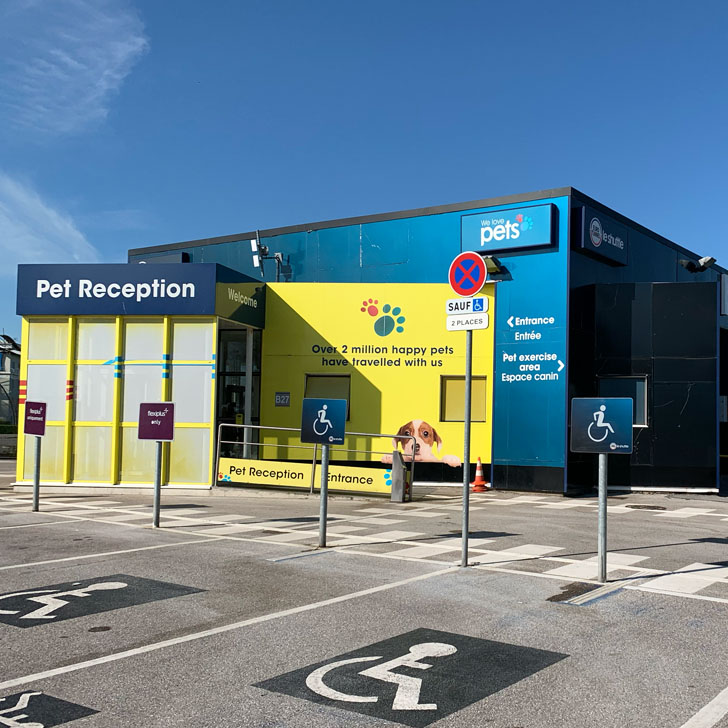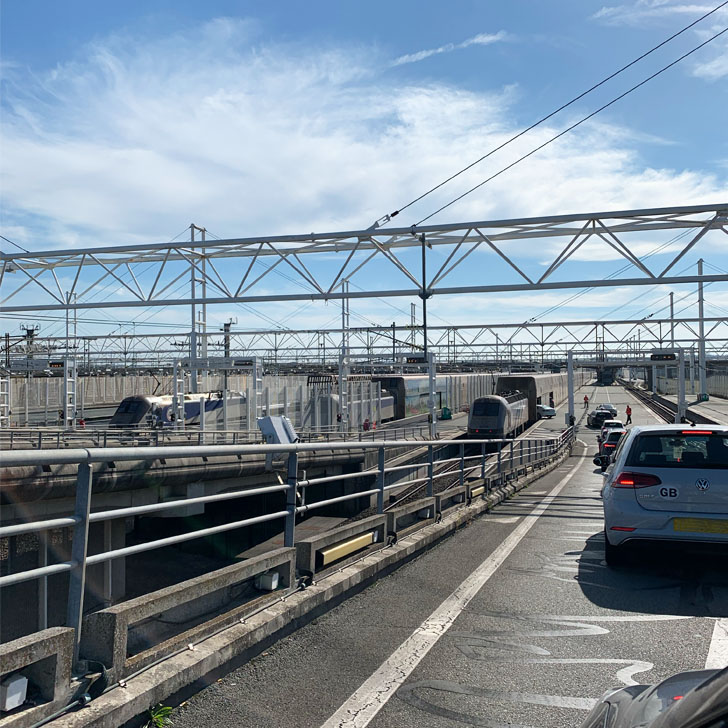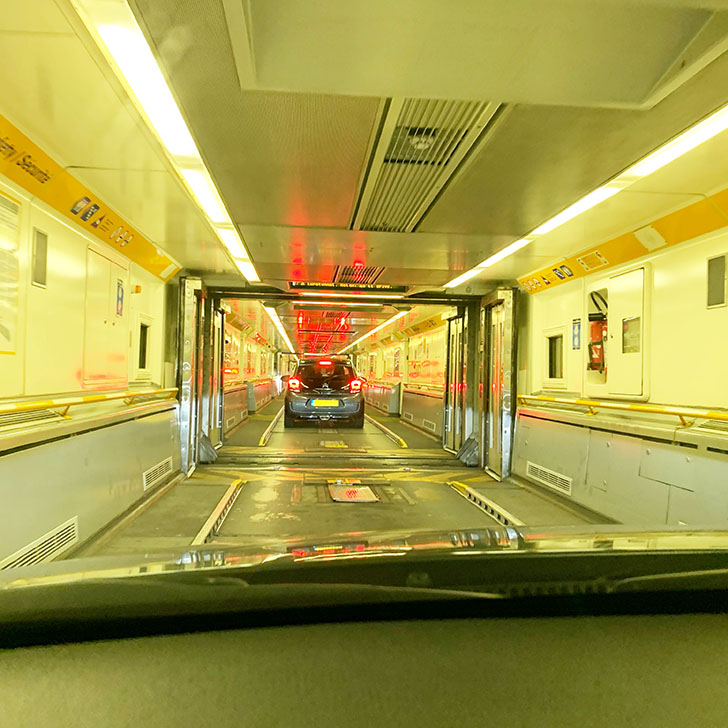
My experience taking the Eurotunnel LeShuttle
Have you ever taken the Eurotunnel LeShuttle? Over the years, we’ve driven from the UK to mainland Europe many times. And would usually take the ferry from Dover to either Calais or Dunkirk. However, with Frank the pup joining us on our travels, we have switched to the Eurotunnel instead. We’ve used it for three return trips so far and have already booked our next trip in a few weeks’ time. So, I thought I would share my experience taking Eurotunnel LeShuttle with you all. In case you wondered what it is like on the Euroshuttle. Or are thinking of booking the Eurotunnel yourself for a trip to mainland Europe.
I will do my best to answer the most common questions about taking the Euroshuttle first, before sharing with you my experience of taking the Eurotunnel LeShuttle:
What’s it like on the Eurotunnel LeShuttle?
How long does it take to go through the Eurotunnel?
How much does it cost to take LeShuttle?
Which tickets are available for the Euroshuttle?
How does boarding work for the Euroshuttle?
Can I get out of the car during the LeShuttle journey?
Can I take my pet with me on the Eurotunnel LeShuttle?
What is better, Eurotunnel or ferry?
What is the Eurotunnel LeShuttle?
Before I share my experience of taking the Eurotunnel LeShuttle, it is probably worth clarifying what the shuttle actually is?
The Euroshuttle, or correctly named the Eurotunnel LeShuttle, is a shuttle train that operates between Folkstone and Calais, going through the Eurotunnel. But this is no normal passenger train, instead you board with your car (or van or motorhome or even lorry). So, they are a bit bigger (and not quite as sleek looking) than normal passenger trains.
Don’t confuse the Euroshuttle with the Eurostar. They both go through the Eurotunnel, but the Eurostar is the high-speed passenger train connecting London with Paris, Brussels and Amsterdam. And believe me, when you see the two trains, there is no mistaking one for the other.
How long does it take to go through the Eurotunnel?
The actual train journey takes around 30 minutes. But you will need to be at the LeShuttle terminal a little earlier for check-in and boarding etc (more on that in a little while). So, the overall time to allow would be more like one and a half hours. At least that was our experience in taking the Eurotunnel LeShuttle.
How much does it cost to take LeShuttle? And which types of tickets are available?
In our experience, the Eurotunnel LeShuttle is slightly more expensive than the ferry. However, you do save time, as the actual journey is only 30 minutes rather than 90 minutes on the ferry. Which is definitely something to take into consideration, when deciding whether to take LeShuttle or ferry.
The lowest price I could find online, was around 79 GBP one way. Prices obviously vary, depending on time of day, travel dates and type of ticket. So, have a look around and play with the days / times before booking. You may be able to save yourself some money, if you can be a little flexible.
There are different types of tickets available for the Eurotunnel LeShuttle:
Day Trip & Overnight
This is the cheapest option (and you might be able to buy a ticket for as little as 31 GBP each way). But as the name already suggests, this is a ticket that requires you to return the same day or latest the next day. And the ticket is non-refundable.
Short-Stay Saver
Next up is the Short-Stay option. Which gives you up to five days between journeys. More expensive than the Day Trip ticket, these tickets start at 79 GBP one way. The short-stay tickets are also non-refundable.
Standard Ticket
If you are planning a week’s holiday in France (or even longer than a week), this is the cheapest ticket you could get. You can book the Standard Ticket one way or return (with as much time as you like between the two journeys). Prices start at 91 GBP one way and are non-refundable.
Standard Ticket Refundable
These are the tickets we have experience with when taking the Eurotunnel LeShuttle. Starting at 131 GBP each way, you will get a refund, should your travel plans change. Given the rather disastrous two years we all had when it comes to travelling, these were the tickets we felt most comfortable with. As we could never be sure whether travel really would go ahead as planned or not. First time we booked Eurotunnel LeShuttle was Christmas 2020. Well, have a guess how that worked out. We ended up cancelling the trip a week before. But thanks to booking refundable tickets, we received the full amount back without any hassle. Same went for Christmas 2021. But I have high hopes for Christmas 2022 (dammit, there I said it and jinxed it, haven’t I?)
And lastly, the Flexiticket
Starting at 249 GBP, these tickets don’t come cheap. But they give you full flexibility and are probably the most luxurious experience when taking the Eurotunnel LeShuttle. You simply turn up and board the next available train. You have a dedicated check-in lane (so no lengthy queueing), as well as an exclusive waiting lounge with free refreshments. I have not tried this option, so I can’t tell you whether the extra money is worth it and if it really betters your experience taking the Eurotunnel LeShuttle. I would just hope it does.
Currently it is not possible to just show up at the port and buy a ticket last minute on the spot. You will have to book your ticket at least 24 hours in advance. Which I guess is fine for most of us. I mean, how often do you wake up in the morning and think to yourself ‘Oh how about a trip to France today?’ … probably not that often. But then again, I do remember one trip years ago, when we were meant to fly to Germany in the evening. And our flight was cancelled (along with many others) after hours of delay. We were unable to rebook for several days… and ended up packing the car, booking a last-minute ferry ticket the next morning and driving to Germany instead.
Little money saving tip when booking your Eurotunnel LeShuttle ticket:
If you live in the UK and have a Tesco Club Card, you can use your clubcard points to buy Eurotunnel LeShuttle tickets. Converting 50p of clubcard vouchers into £1.50 for the ticket. Which effectively means you only pay a third for your LeShuttle ticket if you have enough Tesco Club Card points. However, these tickets are always non-refundable. Keep that in mind, when you use those vouchers. There might well be offers like this available from other retailers. I am only mentioning Tesco Club Card, as that is the one, I personally have. And have seen the offer, although not used yet.
How do I board the Eurotunnel LeShuttle?
Now that we’ve covered the basics, how about I finally tell you a little about our experience taking the Eurotunnel LeShuttle.
Obviously, boarding a train by car is a little different from boarding a passenger train. You don’t just stand on the platform, wait for your train to arrive, and enter.
First up: Check-in
To check in and board the Euroshuttle, you will have to arrive at least an hour before departure. Usually, it would be 45 minutes, but since we had the dog with us, we needed a little extra time.
Once we arrived at the port, the first thing we needed was our booking reference. From there, our next stop was the pet reception, to check Frank in.

For that, we needed to bring the dog, as well as his Animal Health Certificate (or EU passport, if still valid) and they asked us to scan his chip, checking the dog we were taking matched the paperwork we had. Ever since Brexit, taking a dog abroad has become a bit of a challenge, but I won’t go into too much detail here. After all, this post is about our experience taking the Eurotunnel LeShuttle, not the bureaucracy madness caused by Brexit.

Upon check-in, we received a boarding pass, that needed to be displayed in the windscreen (same as you would when boarding the ferry). First time we took the LeShuttle, we got a little confused with said boarding pass. It had a letter and number on it, which we assumed would be the parking lane for boarding (as it would be when taking the ferry). As we boarded an earlier train and were asked to immediately proceed to boarding, we didn’t get a chance to look around and get our bearings on how it all works. We went straight from pet reception into our car, drove off and followed the signs to ‘France’, until we arrived at the boarding area. But whilst our boarding pass said ‘N5’, we could not find a lane N. We did find a lane 5, but that was shut. After some confusion, we decided to chance it and just take the next available lane, regardless of its number.

Which turned out to be the right call. During subsequent trips, we worked out that the letter/number combination on the boarding pass does not indicate where to park for boarding, but when to board. Each train is given a letter and numbers 1, 3 and 5 for the three subsequent boarding times. At check in and all around the premises, large screens show you when each letter/number is due to board. And you will then just head towards the boarding area and join the queue once your letter/number is called.
At the terminal
First time we took the Euroshuttle, we didn’t actually get a chance to explore the terminal either side. As on both occasions we were allowed on an earlier train. And therefore, rushed straight through from pet reception to boarding. But on subsequent visits, we had a little spare time and were able to explore the terminals a little.
Both Folkstone and Calais have customer terminals with a few restaurants, shops, duty-free shopping and restrooms. First few times we’ve taken the Euroshuttle, dogs weren’t allowed inside the terminals, making it a little awkward when travelling with pets.
However, during our most recent trip (yes, we did actually make it home for Christmas this time), Folkestone had updated their terminal and now has a pet lounge. Calais still has a sign outside saying ‘no dogs’ but more and more people were taking the dog inside and no one moaned. But even though dogs are allowed inside the building, they are still not allowed into the actual shops. So, no duty-free shopping.
Border control
Once you are due to board, you will first have to pass border control. But no worries, just follow the signs to ‘France’ or ‘UK’ and you will automatically arrive at border control. Occasionally we had a bit of a queue at border control, but most times this was quick and easy. Along with the passport check, you may also be asked to park up for customs checks. So far, we have not been checked even once, but last time they did ask the two cars ahead of us to go to customs.

Boarding the Eurotunnel LeShuttle train
Border control cleared; we arrived at the boarding area. As mentioned before, you don’t have a dedicated lane. You just park up in the next available lane and wait for boarding to commence. Surprisingly, you can’t actually see the trains yet but trust me when I say they are near.
We had mixed experiences with boarding. Most times it started relatively quick. But on our last trip, we sat for quite a while on the tarmac here, until we were allowed to board. Annoyingly, there is no announcement if a train is delayed. All you get is the info to go to the boarding lanes. But once you are there, you just sit tight and wait. If your wait drags out a little, there are restrooms and vending machines nearby, just in case.
Once boarding commences, you will drive down to the platform and will be directed to the train. The car area of the Eurotunnel LeShuttle train has two levels. We have not yet been upstairs; we’ve always been directed to board on the lower level. But you are stuck in a car in a train in a tunnel… so chances are, the view isn’t any better up there, just saying.

With all cars parked (and squeezed together really tight to allow as many cars on the train as possible), the internal section doors of the train will shut, and the journey will start.
Our experience taking the Eurotunnel LeShuttle: on board the shuttle
The journey through the Eurotunnel takes approx. 30 minutes. When parking the car, you are advised to open your windows a little, as it can get a bit warm and stuffy in the car during that time. Especially in summer. Since you are not allowed to switch on your engine whilst the train is moving, your car’s aircon isn’t much help.

Since this isn’t your normal passenger train, there aren’t many mod cons on board. Yes, there are restrooms every couple of sections, but there is no onboard restaurant or entertainment in any way. First two trips we took, we weren’t even allowed to leave the car. But last time it was all back to normal, and the restrooms were open during the journey.
The Eurotunnel LeShuttle offers onboard Wi-Fi for free. But whilst we were able to connect, it was so slow that we eventually gave up. Instead, we made good use of the half hour journey and had our breakfast instead.
Arriving
Once the train arrives on the other side, it all goes relatively quick. The doors open and everyone drives off the train, onto the platform and out of the station. Do you actually call it a station? Or would it be a harbour? Not a Scooby Doo (clue).
There were no further controls this end, as we had already gone through passport control and customs before boarding the train.
Can I take my pet on the Eurotunnel LeShuttle?
Since I’ve been mentioning our dog about 50 times already, you have probably worked out the answer to that question. Yes, you can take your dog with you when travelling on the Euroshuttle. Which is the whole point, why we started using the Shuttle to start with. And not only dogs, you can also take cats, ferrets and rabbits.
If taking your pet on the Eurotunnel LeShuttle, you must add it to your booking beforehand. And it does come with a little price tag. 22 GBP each way. Which I do find a little annoying, given that I can add an additional person free of charge.
I have already told you about the pet reception, where your pet will be scanned, and its paperwork checked.
And whilst awaiting boarding to commence, you can visit the dog exercise area. Which is nice at Folkstone, with a relatively large run. But the exercise area in Calais is a bit dingy and small, just a fenced in piece of fake lawn, with nothing else to offer.

What is better, Eurotunnel or ferry?
Given our experience taking the Eurotunnel LeShuttle, I do prefer the Eurotunnel over the ferry. At least for us it works better. But both options have their pros and cons.
Yes, the Eurotunnel LeShuttle is quicker (it’ll save you a good hour over taking the ferry). But it is also more expensive than taking the ferry.
And you get less of a view. In fact, you get absolutely no view. Whereas travelling by ferry enables you to see the white cliffs of Dover as you enter or exit the harbour.

Travelling with our dog, we prefer the train, as it means he can stay with us. If going by ferry, dog would need to stay in the car whilst we would have to go upstairs for the crossing. And since plenty of people don’t seem to know how to lock their car without switching on the alarm, this is an experience I would rather avoid for our beloved pup. We took the ferry to the Isle of Wight last year and the moment the ferry started its engines, the car alarms started, and our pup got all restless (and he wasn’t even down in the car, he was up on the deck with us).
Both ferry and train have their advantages and disadvantages. And I leave it up to you to decide which is better. But if you’ve never done it, it sure is an experience taking the Eurotunnel LeShuttle.


